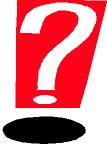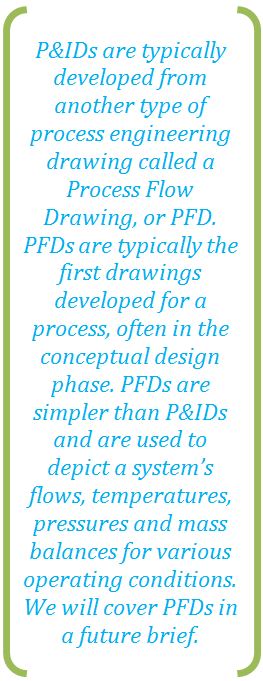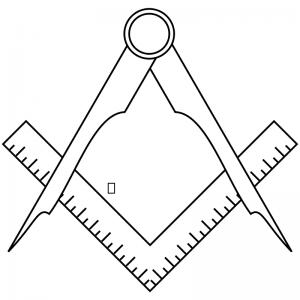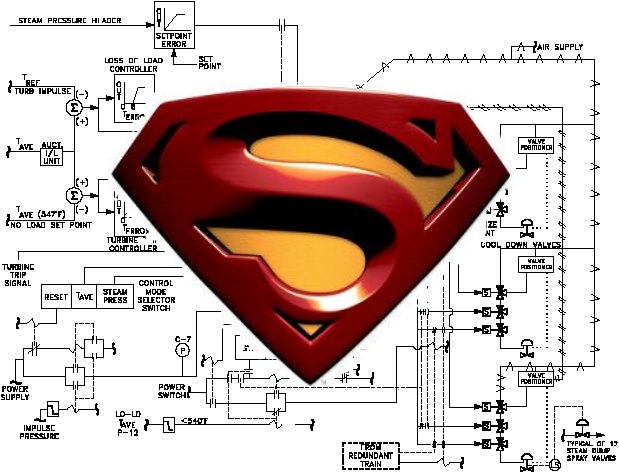
With a Bit of Smoke, a Few Mirrors and a Degree in Hieroglyphics, Anyone Can Learn to Read a P&ID.
Part 2 - The Fundamentals
In Part 1 of this series, I talked about why a solid understanding of P&ID interpretation is important to virtually every discipline involved in a process plant - from process engineering and detail design through construction, commissioning/start-up, operations and management. I'm glad to see I sold you on that point and welcome you back to part two of this saga. Things are starting to heat up and soon we will be weeding out the true process engineers from the causal posers who would rather go off and waste time browsing reddit or digg (which I never do by the way). We still have a bit of the academic stuff to cover before we really dig in but it's important stuff so sit up straight and pay attention! Let's kick things off by defining what P&IDs are and the types of information they illustrate. Afterwards, we'll cover some of their limitations. It's important to know the limitations of a tool so that you don't apply it in the wrong way. At the end of Part 1, I provided a link to some example drawings that I put together to help illustrate some of the concepts I plan to discuss in this series. If you haven't downloaded it yet, please do so now. The file contains:
- Two typical P&ID "Lead Sheets", and
- A few example P&ID drawings
A Word about Lead Sheets
We will talk more about the lead sheets (sometimes referred to as legend sheets) in Part 3 - Symbology. If you've never encountered lead sheets before, for now, just know that lead sheets are used to define the equipment and device symbols, tags and other notations, abbreviations and sometimes esoteric conventions that companies use to develop P&IDs for any project they execute. If you compare lead sheets from a few dozen companies, you will find that 90% of them are pretty much Copy | Paste. For that last 10%?, there can be distinct differences and company-specific conventions used that are not obvious on P&IDs. Therefore, it is good to know where the lead sheets are in your company so you can quickly track down the meaning of that pipe service label or some other obscure symbol.
The Example P&IDs
The last three drawings in the download link include some fairly typical P&IDs. I plan to use these in some upcoming videos to illustrate how the symbols from the lead sheets are applied to a real drawing and then compare that drawing to actual pictures of real-world plants. This will help forge the cognitive connection from the abstract realm of cubicle dwellers at CAD stations to the real world of process plants in action! Even if you are completely new to P&IDs, I'm sure there are some aspects that are obvious to you in these example drawings - things like the equipment and valve symbols, tags, etc. If not, that's OK too because we will get into the details later but for now, just look them over and familiarize yourself with what's there.
What are P&IDs?

A P&ID (or engineering flow drawing, EFD) is a type of process engineering drawing that describes all process design aspects of a plant. In this context, "Process Design" means all the stuff that makes up a plant, including:
- Major and minor equipment - the distinction between what is "major" vs. what is "minor" equipment is subjective
- Valves, including vents, bleeders, safety relief, sample (all of them!)
- Instrumentation, including devices that are used to continuously measure pressure, flowrate, massrate, temperature or some analyzed parameter such as pH, concentration, viscosity...the list goes on.
- Stand-alone controllers that may function independently to perform a particular function, like a PID controller or relay timer.
- Buttons used to control motors and devices, be they pushbutton, toggle, or some other type.
- Motors and drives - many motors are single speed, non-reversing but there are other kinds that have variable speed drives, and can operate in both directions.
- Limit and point devices - including devices that only reveal a discrete state, e.g., if a tank is at a certain level (point level), or a valve or actuator is in a particular position (a limit switch)
- That's it...just kidding.
- Piping (of course!). All the pipes, tubes and even overflows in the plant. Not just the main process pipes inherent to the particular process, but even the utilities (steam, air, fuel, etc.).
- Virtual devices on computer control screens (often as graphical representations real-world objects) that are used to interact with the plant from the control room/panel. This includes things like "clickable" buttons used to start/stop equipment, operate valves, adjust controller settings, setpoint sliders and dials, evaluate alarms, etc. Computer functions and software "links" are generally limited because it is difficult to convey complete control meaning using just symbols. However, it doesn't matter if the process is running on a home-brew Excel VBA project with Dick-and-Jane graphics or a state-of-the-art Honeywell DCS - the symbology used to represent the control interface will be shown.
I probably forgot some stuff in the list above but you get the idea. Clearly there can be a lot of information to show on a P&ID. And for this reason, there are various degrees of detail that a particular company will generally choose to show. There is no formal standard for the various amounts of information a P&ID must include. Rather, it is left to the discretion of the engineers involved. In terms of detail provided, my opinion is that a good P&ID will strike a balance of "clarity without confusion". If you can't see the process for all the symbols, then it's probably overdone. On the other hand, if you can't even discern how a pump may be operated or what interlocks may exist, then you probably need to embellish it a bit.
P&ID Support Documents

For those things that are deliberately left off P&IDs for the sake of clarity, other documents are used to provide the details. Common documents that serve vital support functions to P&IDs include:
- Process Flow Drawings (PFDs) are simple flow drawings that illustrate the general plant streams, major equipment and key control loops. They also provide detailed mass/energy balance data along with stream composition and physical properties. P&IDs originate from PFDs.
- Piping and material specifications. Here, you can dig into all the gory details about materials of construction, gaskets, bolts, fittings, etc. for each of the services. (I will talk about this more in a future post.)
- Equipment and instrumentation specifications. Modern CAD software used to produce P&IDs are sometimes called "smart" because they can incorporate specifications, standards and details that go into the design. Yea, they are cool but just as you can't fix stupid, you can't see "smart". Thus, it's good to have tangible documents that folks can access and digest outside the masters of CAD.
- Functional/process control documents that describe in detail, how the plant operates. A good one will include preferred standards for use on control screens/displays. Folks involved in programming the computers used to operate the plant need these.
How Should P&IDs be Organized?
Now you know what a P&ID is and what goes on them but you're not quite ready for the corner office. At this point it's worth considering how a set of P&IDs can (and should) be organized for a particular process.

There is no single good answer to this question and most companies will have a defined precedent or standard that they follow but if you find yourself at File | New with nothing to go on, because you just started your own company and (whoa...dude I just realized there is no mechanical group anymore) my advice is to keep in mind that when you set out to develop a set of P&IDs you are essentially writing a structured document, not unlike a book or report with chapters/sections and a logical progression. OK, a really boring book with no plot or characters, but you get the idea! My point is, you should plan the structure and break the task down into manageable sections based on area in the plant, function and other criteria that might be of importance to the project/process. Here's a quick example. Consider a process plant with that receives raw feedstock in a storage area, feeds them into some reactor train(s) to make some product and then includes a storage and packaging back end. This particular process might be sitting inside a larger complex and leveraging existing utility infrastructure and tank farms. In this case, you might elect to break the P&IDs down as such:
- Raw material receiving and storage
- Process trains for product manufacture
- Product storage and packaging
- Tie-ins to facility utilities and distribution
- Environmental controsl and specialty unit operations/vendor packages such as thermal fluid, complex unit operations, etc.
Breaking a set of P&IDs down into logical sections makes the drawing set easier to develop, digest and, perhaps most importantly - change. Any of you that have tampered with object-oriented programming should be nodding in agreement at this point. Once you have the categorical areas broken down, the drawing set is then linked together via arrows and notations. Ultimately, it all fits together to like a puzzle to yield a continuous masterpiece.

Some companies like to develop their P&IDs so that if you had a huge wall, you could tape them together and all of the various interconnecting arrows would line up as the parts of a jigsaw puzzle. I have found that such an approach places unreasonable restrictions on the convenient location of equipment and arrows and generally doesn't afford any greater understanding of the holistic process. It's not uncommon for even relatively simple processes to have a dozen or more P&IDs so you would need a really big wall and then you wouldn't be able to read anything without getting close. My advice is to make efficient use of the space provided, use the interconnect arrows as required to link them together and not get caught up on how well they align with the god of geometric continuity (I think that was a Greek god, not sure).
What are P&IDs Used For?
P&IDs really do have vital roles. In fact, if I had to pare it down to the top two, this is my list:
- Act as the definition of the process from which all engineering, fabrication, construction and operation is based.
- Serve as reference for Process Safety Information (PSI) in Process Safety Management (PSM).
To effectively accomplish these objectives, a good set of P&IDs should do the following:
- Provide a clear and concise illustration of all equipment, pipes, valves, instruments, sensors, etc. so that anyone involved has a solid understanding of the process.
- Provide information to assist in analyzing process hazards, safeguards and potential faults so that all kinds of errors (design, human/operation, etc.) are minimized, ideally eliminated.
- Support development of operating and maintenance procedures.
- Serve as an as-built record of the process so that changes can be planned safely and effectively using Management of Change (MOC).
So it's pretty clear that the P&IDs define the process at a root level. They serve as the foundation upon which the system is designed, built and operated. Anyone who tells you that they can design a plant without first generating P&IDs either is a Deity or has endless funds that they enjoy throwing at poorly executed projects during the construction+ phases.
P&ID Limitations
At this point, you might be wondering what P&IDs can't do. After all, so far we've painted a picture that they have seeming supernatural powers. Well, there are a few things that P&IDs don't do well and it's important that you know what these are so that nobody makes any false assumptions because we all know what happens when one assumes.

Despite their illustrious superhero status in the process engineering world, there are a couple things P&IDs don't do well. Let's get it out in the open now:
- They don't reveal scale or geometry,
- They don't serve as a true model for how things are oriented and placed in the real world.
Like I said in the intro to this series, I've been doing process engineering for 150 years (in the snow, uphill to work both ways) and I still run into instances where somebody will base a decision on how to make a change or try to find something in the plant based on where or how it looks on the P&ID. Here's a ProTip - a better way to get a handle on where things really are at in the field is to use the P&IDs as a guide and do a walk-down or find other scale drawings. Good examples of true scale drawings are the ones used by contractors to build the plant. These include civil and piping plans, sections and/or isometrics, skid/equipment fabrication drawings, instrument location plans, etc. If you just assume that a pipe is located somewhere because it looks that way on the P&ID, you might be disappointed! Since we're exposing the superman P&IDs to a bit of kryptonite, let's review some other weaknesses of P&IDs just to make sure we've covered all the key points:
- Not to Scale - as stated above, P&IDs can't be relied on as a scale guide for where pipes, equipment or other items are in proximity to equipment in the real world. Yes, I'm repeating that again because it will be on the quiz.
- Not Geometrically Accurate - P&IDs don't illustrate geometry. The level of detail that goes into symbols for equipment will vary, but is almost never geometrically correct!
-
Color Blind - P&IDs are not good at using color to convey meaning. While the folks who draw them often use color to help spot things on a monitor, don't try too hard to glean meaning from color printouts or you may just end up seeing stars...
- Not Definitive - P&IDs do not include complete specs for all of the equipment in the process. They are, after all drawings, not documents. If you need details, grab the pertinent data sheets or vendor specs. Or ask someone for some help.
- Not Drawn Consistently - Sadly, P&IDs seldom look consistent between companies. That's because there is a lot of flexibility in how one can go about drawing a P&ID (due to various standards, CAD systems, etc.) and that leaves them open to company and/or personal preferences. As a result, P&IDs often take on a different "look and feel" from company-to-company or even from job-to-job inside the same company. This can be a point of confusion when you get used to a certain way of seeing them. But don't sweat it; just reorient yourself to the ways and means used by the process tribe in your group. Did you just think about lead sheets! Bonus point for you!
OK, so now you have a solid feel for what P&IDs are, the purposes they serve and their limitations. Hopefully, you've taken the time to at least glance at the example drawings provided. Great, in Part 3 of this series we will dig into the symbology used so we can interpret the geek speak of process engineers!




Comments
then please let me know how to decide an instrument device has an I/O in order to arrange an I/O list. thanks
Hi Rob, great job. Although I am a chemical engineer, I am new to this topic. It would be nice if you can also post a PDF version of the lecture notes. I am comfortable in reading from the paper than on my computer. Thanks and looking forward to more insights. Sanjib
How to comment a P&ID for the possition of OR&A engineer ?
Dear Robert, i am really impressed by the knowledge you have and the detail you wrote in this article. Even i have wrote an article related to Piping and Instrumentation Diagram - <a href="http://www.pipingguide.net/2008/12/piping-instrumentation-diagram.html" rel="nofollow">http://www.pipingguide.net/2008/12/piping-instrum...</a>. I hope you'll like reading it once. Please let me know some feedback as well about it.
This series has been very helpful to me, Process Engineering is not one of my strong suits (I'm more of a researcher) and I'm trying to expand my technical expertise, this has been a great source of help! Keep up the great job Rob, :)
Lucidchart just released a P&ID library so you can diagram out your ChemE HW online. Makes it easy to work on group projects and integrates with Google Apps
Here is the link if anyone is interested. <a href="https://www.lucidchart.com/pages/process-engineering-p-and-id-diagrams" rel="nofollow">https://www.lucidchart.com/pages/process-engineer...</a>
this is great work and this is very valuable info...thank you
Quick question because I can't find a standard. Is there an appropriate way to depict a stream with two-directional flow on a P&ID? A process I am AutoCADing uses a pipeline where solids flow down due to gravity, and gas flows up from the high to low pressure difference. How is this represented? How should this pipeline be labeled? Thank you!
Dear Mr. Cook thank you very much for your initiative. I highly appreciate your effort. Till now I have only one question in my mind. In your writing I found you mentioning " I plan to use these in some upcoming videos". May I request you to provide me some information regarding those videos? I mean any streaming or download link would be sufficient. I reckon that those videos might enhance the overall learning process. Thanks in advance and I hope to hear from you soon.
Mr Cook, I am developing a best Practice document for P&ID field verification. Any documents that you can provide on how its done would be greatly appreciated.
Mr Cook , your material is really helpful being a process instrumentation and controls engineer , these links are really helpful to brush up on lost topics. can you provide more information regarding p&id for field verification